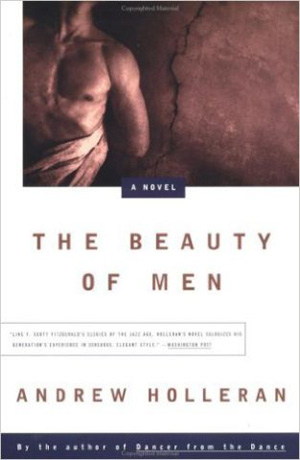 The Beauty of Men
The Beauty of Men
by Andrew Holleran
Published by William Morrow & Co
Published June 1996
Fiction
272 pgs. • Find on Amazon.com
Reviewed by Stephen O. Murray
July 8, 2001
At the time the book was published, I heard Andrew Hollernan say that The Beauty of Men grew out of a diary he kept, though he also claimed that the novel is not autobiographical, and that he is not Lark, the central character who (like Hollernan) has left Manhattan and the ravages of his AIDS on his circle to mopes around in Florida, waiting for his rest-home-stored mother to die and spending most of the time not spent sitting with his mother cruising men at a nearby boat-launching ramp.
Although Hollenran sounded healthier, less self-loathing and closeted than Lark, many of Lark’s attitudes echo those expressed by Hollernan’s essays in Christopher Street and The Gay and Lesbian Review. It is hard for me not to see the protagonists of his three [now four] novels as pretty much the same character at three different ages. I know they are novels, but has he any powers of invention? or only gifts for description and (queenly) exaggeration? He certainly has no interest in constructing plots!
I once called Dancer from the Dance a fictionalization of clone self-hatred. The Beauty of Men is another one with the added guilt of its narrator remembering having in his heyday ignored older men the way Lark now finds younger men contemptuously turning away from him. He is fully aware of the live by the sword, die by the sword justice of this. Although he wallows in self-pity, he does not try to preach or complain to who have no idea that they too are mortal.
If Dancer scared David Leavitt and others twenty years ago, what will Beauty do to those who pick it up to try to learn what lies ahead for them or to find out what gay mid-life is like? Every homophobic cliché is there: sterility, deprivation of paternal bonding, absorption with the mother, sexual compulsiveness, inability to grow up and settle down, being doomed to loneliness after 40, having no interest in a career, there’s even a suicide (of someone HIV-). And there’s even direct continuity with the original Sodomites demanding to see and try the fresh meat (p. 214)!, albeit not of angels, and in a culture with very different notions of hospitality than in ancient Palestine.
Lark has no visible means of support. Presumably, he inherited and/or controls money accumulated by his father, though it still seems natural to Hollernan in his late 50s or early 60s for gay men to cruise full time and not have jobs (“I’ve devoted my whole life to being homosexual,” p. 23). I think a job would almost certainly be good for Lark’s mental health: becoming absorbed in the little dramas and comedies of one’s co-workers might distract him from himself and his loathing of himself. .
Lark knows that he is self-loathing, that he was alienated from gay life before AIDS (and another in-group father figure, this time named Sutcliffe rather than the Sutherland of Dancer from the Dance) tries to talk sense to him, specifically that AIDS is not God’s punishment. Lark knows that his obsession with Becker is doomed and foolish. He knows that he is carrying an absurd, very unhealthy load of guilt. But knowing that does not lighten the load. Even an acute analysis is not a cure (alas!).
There are no significant non-whites in the book, even though it is set in the American South. I seem to recall an attractive Asian glimpsed, and a Jamaican providing company in a bathhouse tv room, but there are no speaking parts for non-whites, and no southern blacks or Latinos at all—in a book set in Florida. Holleran is not just ethnocentric and narcissistic, but strikes me as being a purveyor of solipsism.
published by epinions 8 July 2001
©2001, 2016, Stephen O. Murray

